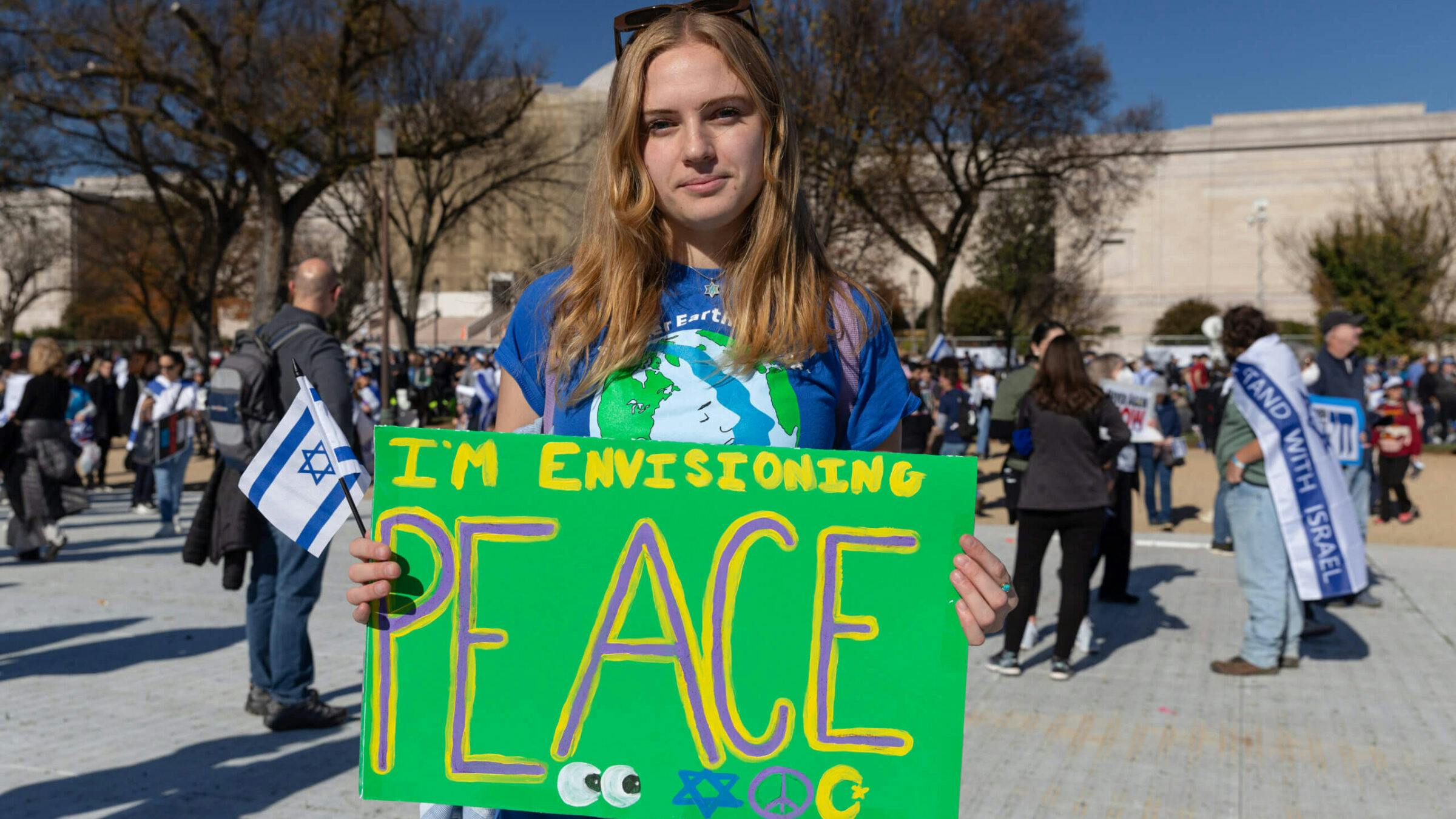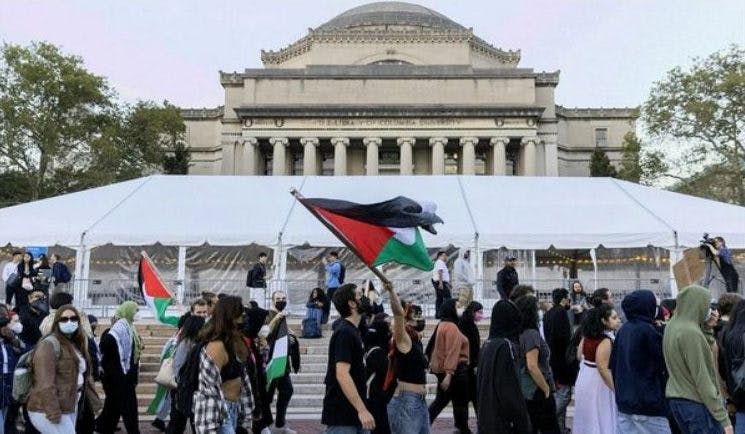Published: 11 December 2023
Last updated: 5 March 2024
Since October 7, the Zionist left is reengaging to broaden the establishment’s big tent — and the anti-Zionist left is staying far outside, writes YEHUDA KURTZER.
I see two clear political realignments that are operating in tandem. The first is that the messy mainstream of American Jews is energized anew toward identification with Israel and the Jewish people, expressing that identification with levels of belonging that represent a reversal of decades of assimilation and decline, and coalescing back into a big tent. The second is a real rupture between the Jewish left and the rest of the Jewish community to which it was once attached, and its coalescence into a separate tent of its own.
When I talk about the messy mainstream, what I mean is the politically and religiously liberal majority of American Jews, who have a wide variety of observance and affiliation rates. It is messy because this group exhibits deep disagreements about the value and meaning of boundaries between Jews and non-Jews, and tends to behave and practice Judaism in ways that challenge the very existence of such boundaries.
This is the sector of Jewish life that many of us have watched and worried about for the past few decades as its connection to Israel eroded, whether because of concern over Israel’s increasingly right-wing governance, or simply out of distance and apathy. At the Shalom Hartman Institute we’ve termed this group the “troubled-committed,” and we’ve worried that this population was at risk of exiting from the Jewish community.
Now I see signs of reengagement, reflected in higher turnout at synagogue, Hillel and Chabad events, and expressed on social media as a response to a sense of alienation from a gentile world that does not take Jewish pain and trauma seriously. This is happening at all ages.
For some liberal Jews, this act of recognition and return may reflect a real existential transformation away from those exact liberal values and commitments they held dear for a long time. It is something of a replay of the prior generation’s anti-Communist turn in the 1960s and 1970s, a journey inward from the universal to the particular.
One colleague, a university professor horrified by colleagues’ inabilities to mouth even platitudes condemning Oct. 7, told me she is leading herself through an active process of “de-lefting.”
For others it may be less radical, and more subtle. Many are simply realizing that they have always been more ontologically Jewish than they acknowledged, and are feeling more emotionally available to be claimed by the needs of the Jewish people.
American Jews who feel frustrated that their liberal allies didn’t show up reciprocally as they themselves stood for racial justice are not now going to abandon their commitments to racial justice or other movements. They are just more likely now than before to be more cautious in their expectations from the whole business of allyship. Liberal Jews have long been castigated by some on the far left as “progressives except for Palestine”; now that epithet may become true, and a source of pride.
The big tent is making a comeback
With an increased interest in belonging, the Jewish community’s “big tent” is making a comeback. That tent had been contracting for decades, thanks to exoduses on either end of the political map, along with a self-defeating tendency to more aggressively police its boundaries.
But in the last few weeks, the establishment organizations kicked into gear with wildly successful campaigns of crisis fundraising, rallies, and solidarity missions. It’s been an important reminder of the absolute necessity of unwieldy consensus political instruments and the muscle memory of solidarity that had atrophied over time.
This is all a big deal. It means the return, for individuals, of Jewish political identities that are a little less partisan and a little more discerning in terms of broader agendas. On a collective level, a revitalized Jewish big tent makes possible more diversity of views within the organized Jewish community, and might even translate to a more effective exercise of Jewish communal power. A community divided cannot advocate for itself.
The broad tent was on display at the rally in Washington earlier this month. I was grateful that the so-called peace bloc of progressive Zionist organizations showed up — and, at odds with some others in the crowd, insisted on booing the Rev. John Hagee when he took the podium.
In both showing up and expressing their displeasure, these groups showed their full-throated commitment to redefining the tent poles so they are included — and so that extreme voices on the right are at least as uncomfortable in that tent as they are.
In the messiness of the big tent, we commit enough to what we share to tolerate our disagreements; then, protected by the overarching framework, we fight like hell on those disagreements. This means that the establishment now must be far more welcoming to the Zionist left: If they are standing in the tent despite their discomfort, it is on those holding the tent poles to make them feel more comfortable.
This is not just a reciprocal obligation. It is a necessity, because if the establishment keeps pushing its left flank out — as it has for decades, to organizations like J Street and the New Israel Fund — it will risk losing all the gains it is currently making, the vast numbers of people waking up now to Israel’s vulnerability and prioritizing that awareness as part of their political identities.
A stronger tent can easily lead to a stronger response against those who choose to stand outside of it. There is a reckoning underway in Jewish philanthropy and institutional life, as organizations are revisiting their grant portfolios and mission statements to make their commitments to Israel and Jewish peoplehood clearer — and cutting ties where they feel compromised.
But it would be self-defeating for the revitalized liberal Zionist mainstream to spend too much energy policing its boundaries. Since the red lines are brighter now than ever, the big tent should be inclusive of anyone seeking to belong. One fascinating outcome of this could mean that we stop the decadeslong obsession with intermarriage as the marker of Jewish peoplehood. After Oct. 7, identification with the Jewish people at a time of suffering is a much healthier, and maybe more accurate, indicator of belonging.
Some will doubtlessly see this as redefining the parameters of Jewishness through loyalty to Israel. This is sometimes criticized as making “pro-Israelism” a replacement of “Judaism.” I disagree: Some of our oldest and most traditional understandings of belonging to the Jewish people are rooted in exactly this question — In a moment of crisis, are you with us?
A tent of their own
That is exactly the question that has defined the second major political shift, the hardening of the Jewish far left around anti-Zionism, and the construction of an alternative tent.
Prior to Oct. 7, I was sensitive to the nuanced distinctions among organizations like IfNotNow, Jewish Voice for Peace, and — outside the Jewish community — Students for Justice in Palestine.
Since Oct. 7 the differences between these organizations have functionally collapsed. They have embraced a shared strategy and, with only a few exceptions, coalesced their movements into the same protests, vocabulary, and messaging.
The most dramatic expression of that shared messaging is what seems now an open repudiation of Zionism altogether, and a stark commitment to tendentious rhetoric about colonialism, the Israeli perpetration of genocide, and other left dogmas that situate their commitments squarely outside the framework of Jewish communal respectability.
This shift includes an implicit decision to no longer even seek to influence the establishment, which was essential to the founding of IfNotNow nearly 10 years ago. That group’s founders were products of Jewish institutional systems and then wanted them to reflect the values systems they claimed to espouse. I remember being in the lobby of an AIPAC conference with a group of rabbis whose children were outside with IfNotNow. The adjacency to the establishment, and these bonds of kinship, gave the critique of the protesters immense power.
The clear decision since Oct. 7 to instead constitute a bloc that swims entirely in the language and politics of the left, rather than remaining adjacent to the Jewish community, may be liberating for these organizations. They may benefit from more stakeholders and more passionate participation. But it is also freeing for the left end of the establishment to feel unburdened by these organizations.
In some ways, this left solidarity is not surprising and follows from the solidarity process underway over in the center. Those outside a major moment of consolidation, who feel threatened by it, circle their own wagons.
I understand that some on the far left feel that the Jewish community has moved the goal posts in what they see as an embrace of war and what they characterize as depraved indifference to mass Palestinian death. While mainstream American Jews see Oct. 7 as a reminder of Jewish victimhood, those on the far left see the Israeli response as breaking new ground in Jewish aggression. And this may mean they are willing to accept the philanthropic and institutional consequences of their self-imposed ostracism. This signals an end of an era, when both the establishment and the Jewish left accept the terms of the rupture.
Centering the Palestinian struggle
This shift was, perhaps, foreshadowed when the leftist magazine Jewish Currents published an article in 2021 in which a Palestinian intellectual argued for the legitimacy of resistance against Israel “by any means necessary.” In the immediate aftermath of Oct. 7, it only became more blunt. One Currents contributing editor tweeted, “Glory to the resistance,” and a reporter publicly questioned the allegations of rapes by Palestinian “fighters.”
No dissenting editorial voice emerged from the magazine’s leadership. Wars inherently polarize our disagreements, and this was a stark staking of new ground by a Jewish left that seems entirely disinterested in the claims of Jewish peoplehood and solidarity as they define the terrain for the vast majority of world Jewry.
The Jewish left now seems to be thinking of the Palestinian cause not as an expression of allyship but as its own core identity. When Jewish Voice for Peace shut down the Manhattan Bridge earlier this month, their public imagery placed front and center the Palestinian American activist Linda Sarsour, a controversial figure who has sown deep divides in the feminist movement in policing the participation of Zionists.
A generous way to read this is through the prism of messy coalitions — that Sarsour is an uncomfortable member of the Jewish left’s tent, just as many of us were uncomfortable with Hagee speaking at the Washington rally.
But no one in the messy mainstream would place Hagee at the center of our movement, and we tolerate folks in our midst who dissent from his involvement altogether. I have yet to see any public dissent within the Jewish left about Sarsour’s prominent role at the Manhattan Bridge event — or frankly, about any of the many egregious, outrageous moral failings it has exhibited since Oct. 7.
The only dissent has come from people who are essentially declaring that they must leave the movement. I find this incriminating, and also a loss: Those of us not on the left would learn a lot from a version of it that was more openly self-critical and less dogmatic, and more generous back to us — especially around the matters of life and death that the Jewish people now face.
And I worry that means the Jewish left will have no seats at any tables besides the ones they set for themselves.
A new window of opportunity
These two political realignments offer us two important possibilities. The first is to find better ways to differentiate between institutions and individuals. An even bigger window of opportunity that has finally yawned open is for the liberal Zionists and the Zionist left to join together to reshape the Jewish establishment that has ignored them for years.
I have been trying very hard to sustain relationships with people I care about who are loyal to institutions that do things I cannot tolerate. I think those relationships are the only long-term way that we make sure that individuals do not calcify into ideologies. Just as it is unconscionable for an AIPAC member’s home to be targeted by pro-Palestinian protesters, it is essential that when Jews find ourselves on opposite sides of a dividing line, we do not dehumanize or make one another proxies for the ideologies of institutions we detest. Life is long and people change, and any red lines we draw should focus more on institutions than individuals.
And second, as the liberal Zionists and the Zionist left secure their place in the big tent, the establishment organizations will have to pay attention. The Zionist left is enduring dissent in its ranks and choosing to stay in solidarity with the messiness of the Jewish people. This needs to be rewarded, not derided.
A principled Zionist left here in the U.S. will look and sound a lot more like the Zionist left in Israel. That means a basic paradigm of respecting the dignity and legitimacy of Jewish lives and Jewish self-determination while advancing the cause of Palestinian human, civil, and national rights in the same breath.
A liberal Zionist camp thrives in between the quietism to its right and the shrill certitude to its left. The strengthening of the Zionist left within the messy mainstream is a major cause for optimism; it wards off the ferocity of the anti-Zionist left while simultaneously representing a vision for Jewish politics that blends integrity with belonging, the universal and the particular.
Oct. 7 broke the Jewish polity. Maybe it also will allow us to finally fix it.
To contact the author, email opinion@forward.com.
This article was originally published on the Forward.
READ MORE
How Oct. 7 is reshaping the Zionist — and anti-Zionist — left in the US (The Forward)
RELATED STORIES
Younger US Jews are 'pro-Israel' in a different way (Irwin J. Mansdorf, Jerusalem Post)
What does "pro-Israel" mean for the younger generation of Jews?
Scholars researching Islam and psychological analysis of Gen-Z say progressives being drawn to Islam is a rebellion of sorts against Western establishment and culture.
New polls reveal what Americans think of the Israel-Hamas war (YNet)
Pew research finds a quarter of Americans believe Israel going too far in current military operation while nearly the same number believe Israel's actions are the right approach; UK poll finds a third of young Americans say Holocaust a myth.



